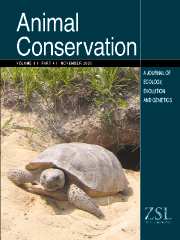Crossref Citations
This article has been cited by the following publications. This list is generated based on data provided by
Crossref.
Packer, C.
Altizer, S.
Appel, M.
Brown, E.
Martenson, J.
O'Brien, S. J.
Roelke‐Parker, M.
Hofmann‐Lehmann, R.
and
Lutz, H.
1999.
Viruses of the Serengeti: patterns of infection and mortality in African lions.
Journal of Animal Ecology,
Vol. 68,
Issue. 6,
p.
1161.
Sainsbury, Anthony W.
Nettleton, Peter
Gilray, Janice
and
Gurnell, John
2000.
Grey squirrels have high seroprevalence to a parapoxvirus associated with deaths in red squirrels.
Animal Conservation,
Vol. 3,
Issue. 3,
p.
229.
Hedrick, Philip W
Lee, Rhonda N
and
Parker, Karen M
2000.
Major histocompatibility complex (MHC) variation in the endangered Mexican wolf and related canids.
Heredity,
Vol. 85,
Issue. 6,
p.
617.
Daszak, Peter
Cunningham, Andrew A.
and
Hyatt, Alex D.
2000.
Emerging Infectious Diseases of Wildlife-- Threats to Biodiversity and Human Health.
Science,
Vol. 287,
Issue. 5452,
p.
443.
Woolhouse, M. E. J.
Dye, C.
Cleaveland, S.
Laurenson, M.K.
and
Taylor, L.H.
2001.
Diseases of humans and their domestic mammals: pathogen characteristics, host range and the risk of emergence.
Philosophical Transactions of the Royal Society of London. Series B: Biological Sciences,
Vol. 356,
Issue. 1411,
p.
991.
Haydon, D. T.
Laurenson, M. K.
and
Sillero‐Zubiri, C.
2002.
Integrating Epidemiology into Population Viability Analysis: Managing the Risk Posed by Rabies and Canine Distemper to the Ethiopian Wolf.
Conservation Biology,
Vol. 16,
Issue. 5,
p.
1372.
2002.
Tending Animals in the Global Village.
p.
245.
Hedrick, Philip
2002.
Reproductive Science and Integrated Conservation.
p.
97.
Holt, William V.
Pickard, Amanda R.
Rodger, John C.
and
Wildt, David E.
2002.
Reproductive Science and Integrated Conservation.
p.
21.
Hedrick, P. W.
Lee, R. N.
and
Garrigan, D.
2002.
Major histocompatibility complex variation in red wolves: evidence for common ancestry with coyotes and balancing selection.
Molecular Ecology,
Vol. 11,
Issue. 10,
p.
1905.
Nunn, Charles L.
Gittleman, John L.
and
Antonovics, Janis
2003.
A comparative study of white blood cell counts and disease risk in carnivores.
Proceedings of the Royal Society of London. Series B: Biological Sciences,
Vol. 270,
Issue. 1513,
p.
347.
Randall, Deborah A.
Williams, Stuart D.
Kuzmin, Ivan V.
Rupprecht, Charles E.
Tallents, Lucy A.
Tefera, Zelealem
Argaw, Kifle
Shiferaw, Fekadu
Knobel, Darryn L.
Sillero-Zubiri, Claudio
and
Laurenson, M. Karen
2004.
Rabies in Endangered Ethiopian Wolves.
Emerging Infectious Diseases,
Vol. 10,
Issue. 12,
p.
2214.
Fiorello, Christine V.
Deem, Sharon L.
Gompper, Matthew E.
and
Dubovi, Edward J.
2004.
Seroprevalence of pathogens in domestic carnivores on the border of Madidi National Park, Bolivia.
Animal Conservation,
Vol. 7,
Issue. 1,
p.
45.
Admasu, Ermias
Thirgood, Simon J.
Bekele, Afework
and
Karen Laurenson, M.
2004.
A note on the spatial ecology of African civet Civettictis civetta and common genet Genetta genetta in farmland in the Ethiopian Highlands.
African Journal of Ecology,
Vol. 42,
Issue. 2,
p.
160.
SWINNERTON, K. J.
GREENWOOD, A. G.
CHAPMAN, R. E.
and
JONES, C. G.
2005.
The incidence of the parasitic disease trichomoniasis and its treatment in reintroduced and wild Pink PigeonsColumba mayeri.
Ibis,
Vol. 147,
Issue. 4,
p.
772.
Deem, Sharon L.
and
Emmons, Louise H.
2005.
EXPOSURE OF FREE-RANGING MANED WOLVES (CHRYSOCYON BRACHYURUS) TO INFECTIOUS AND PARASITIC DISEASE AGENTS IN THE NOËL KEMPFF MERCADO NATIONAL PARK, BOLIVIA.
Journal of Zoo and Wildlife Medicine,
Vol. 36,
Issue. 2,
p.
192.
Heffernan, J.M
Smith, R.J
and
Wahl, L.M
2005.
Perspectives on the basic reproductive ratio.
Journal of The Royal Society Interface,
Vol. 2,
Issue. 4,
p.
281.
FIORELLO, CHRISTINE V.
NOSS, ANDREW J.
and
DEEM, SHARON L.
2006.
Demography, Hunting Ecology, and Pathogen Exposure of Domestic Dogs in the Isoso of Bolivia.
Conservation Biology,
Vol. 20,
Issue. 3,
p.
762.
Randall, D.A.
Marino, J.
Haydon, D.T.
Sillero-Zubiri, C.
Knobel, D.L.
Tallents, L.A.
Macdonald, D.W.
and
Laurenson, M.K.
2006.
An integrated disease management strategy for the control of rabies in Ethiopian wolves.
Biological Conservation,
Vol. 131,
Issue. 2,
p.
151.
Haydon, D. T.
Randall, D. A.
Matthews, L.
Knobel, D. L.
Tallents, L. A.
Gravenor, M. B.
Williams, S. D.
Pollinger, J. P.
Cleaveland, S.
Woolhouse, M. E. J.
Sillero-Zubiri, C.
Marino, J.
Macdonald, D. W.
and
Laurenson, M. K.
2006.
Low-coverage vaccination strategies for the conservation of endangered species.
Nature,
Vol. 443,
Issue. 7112,
p.
692.


